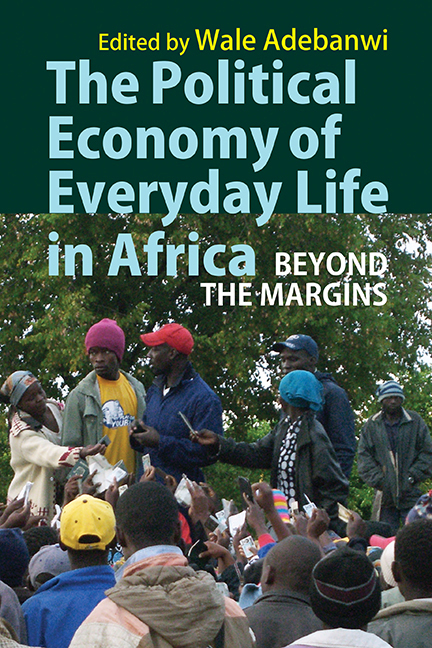Book contents
- Frontmatter
- Dedication
- Contents
- Maps, Illustrations & Tables
- Notes on Contributors
- Foreword
- Acknowledgements
- Approaching the Political Economy of Everyday Life An Introduction
- Part I MONEY MATTERS: CURRENCY & FISCAL LIFE STRUGGLES
- Part II LABOUR, SOCIAL LIVES & PRECARITY
- Part III MARGINALITY, DISAFFECTION & BIO-ECONOMIC DISTRESS
- Part IV HISTORICITY, TEMPORALITY, AGENCY & DEMOCRATIC LIFE
- 11 History as Value Added? Valuing the Past in Africa
- 12 Cultural Mediation, Colonialism & Politics Colonial ‘Truchement’, Postcolonial Translator
- 13 ‘Kos'ona Miran?’ Patronage, Prebendalism & Democratic Life in Contemporary Nigeria
- Afterword: The Landscapes Beyond the Margins Agency, Optimization & the Power of the Empirical
- Index
12 - Cultural Mediation, Colonialism & Politics Colonial ‘Truchement’, Postcolonial Translator
from Part IV - HISTORICITY, TEMPORALITY, AGENCY & DEMOCRATIC LIFE
Published online by Cambridge University Press: 31 August 2018
- Frontmatter
- Dedication
- Contents
- Maps, Illustrations & Tables
- Notes on Contributors
- Foreword
- Acknowledgements
- Approaching the Political Economy of Everyday Life An Introduction
- Part I MONEY MATTERS: CURRENCY & FISCAL LIFE STRUGGLES
- Part II LABOUR, SOCIAL LIVES & PRECARITY
- Part III MARGINALITY, DISAFFECTION & BIO-ECONOMIC DISTRESS
- Part IV HISTORICITY, TEMPORALITY, AGENCY & DEMOCRATIC LIFE
- 11 History as Value Added? Valuing the Past in Africa
- 12 Cultural Mediation, Colonialism & Politics Colonial ‘Truchement’, Postcolonial Translator
- 13 ‘Kos'ona Miran?’ Patronage, Prebendalism & Democratic Life in Contemporary Nigeria
- Afterword: The Landscapes Beyond the Margins Agency, Optimization & the Power of the Empirical
- Index
Summary
I admit that it is a good thing to place different civilizations in contact with each other; that it is an excellent thing to blend different worlds; that whatever its own particular genius may be, a civilization that withdraws into itself atrophies; that for civilizations, exchange is oxygen; that the great good fortune of Europe is to have been a crossroads, and that because it was the locus of all ideas, the receptacle of all philosophies, the meeting place of all sentiments, it was the best center for the redistribution of energy. But then I ask the following question: has colonization really placed civilizations in contact? Or, if you prefer, of all the ways of establishing contact, was it the best? I answer no. And I say that between colonization and civilization there is an infinite distance.
(Aimé Césaire, Discourse on Colonialism 2001: 11–12)Every culture wants to be self-sufficient and use this imaginary self- sufficiency in order to shine forth on the others and appropriate their patrimony. Ancient Roman culture, classical French culture, and modern North-American culture are striking examples of this. Here, translation occupies an ambiguous position. On the one hand, it heeds this appropriationary and reductionary injunction, and constitutes itself as one of its agents. This results in ethnocentric translations, or what we may call ‘bad’ translations. But, on the other hand, the ethical aim of translating is by its very nature opposed to this injunction: The essence of translation is to be an opening, a dialogue, a crossbreeding, a decentering. Translation is ‘a putting in touch with,’ or it is nothing.
(Antoine Berman, The Experience of the Foreign 1992: 4)Let me start with a scene from a book by anthropologist, historian, novelist, but above all interpreter then translator of West African oral cultures and literatures into French: Amadou Hampâté Bâ (1901–1991) from Mali. The book is entitled Vie et enseignement de Tierno Bokar le Sage de Bandiagara (literally: ‘The life and teachings of Tierno Bokar, the Sage of Bandiagara’) and is the biography of his master and guide in Islamic sciences and spirituality (Tierno means ‘master’). The scene in question takes place in 1937, in the Malian town of Mopti under French colonial rule.
- Type
- Chapter
- Information
- The Political Economy of Everyday Life in AfricaBeyond the Margins, pp. 308 - 317Publisher: Boydell & BrewerPrint publication year: 2017
- 2
- Cited by

